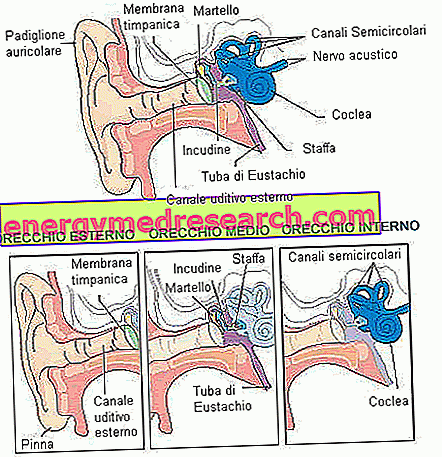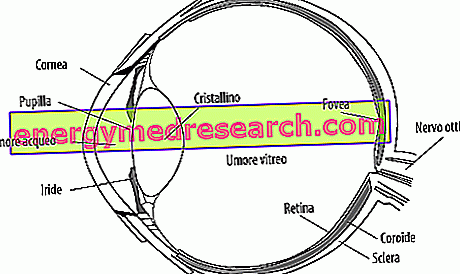Generality
Gastric banding is a surgical procedure indicated for the treatment of obesity. It comes, with its various techniques used, in restrictive bariatric surgery, intended to limit the consumption of food through the surgical reduction of the stomach volume; it follows, for obvious mechanical reasons, an early onset of the sense of satiety and a reduced ability to take food. Thanks to the gastric stenosis induced by the bandage, when the operated subject eats he feels full even after the ingestion of a small quantity of food, to the point that if he continues to eat he is induced to vomit. Consequently, the amount of food introduced will necessarily be lower than it was used to ingest before bandaging: body weight will decrease accordingly.
The main gastrorectorial interventions that use gastric banding are:
- Laparoscopic adjustable gastric banding ( LAGB or Lap-Band'® ): currently, it is the most widespread method. It is performed by laparoscopy, therefore it represents a minimally invasive operation, and is reversible: the gastric cavity is not sectioned and the bandage can be removed;
- Vertical gastroplasty ( VBG ): the reduction in stomach volume is guaranteed by a surgically implanted device. The surgeon creates a gastric pouch by separating it from the rest of the stomach with cuts and sutures, which allow the placement of a polypropylene strap that will alter the anatomy of the stomach (the gastric cavity is sectioned).
Like other methods designed to combat obesity, gastric banding requires high patient adhesion to an appropriate dietary regime after surgery.
Adjustable gastric banding
Adjustable gastric banding is one of the most common surgical procedures for treating obesity, which was only overcome by gastric bypass.

The system consists of an inflatable bandage (silicone band), surgically implanted around the upper part of the stomach and fixed to the gastric fundus in order to avoid slipping of the device or herniation of the stomach.
The surface of the band is adjustable: its size depends on the amount of sterile saline solution found inside the constrictive bandage. Through a thin connection catheter and a subcutaneous reservoir, the surgeon can adjust the diameter of the device around the stomach, adding or removing saline solution (inserts a needle at the level of the access tank, placed under the skin). This allows the amount of "choking" to be modulated to increase or reduce the level of passage of food, from the upper pocket to the stomach body. The achievement of the desired weight loss is in fact correlated to the degree of pressure exerted by the fascia, on which the width of the gastric pouch that is created depends.
The bandage limits the amount of food that can be ingested in a single meal and increases the time needed to digest the introduced foods. The laparoscopic adjustable gastric band is indicated for obese patients with a body mass index (BMI) of at least 40, who have failed by adopting non-surgical alternatives to lose weight, such as controlled diet, exercise drugs and behavior modification programs food. Furthermore, it is also approved for patients with a BMI of 30-40, with one or more obesity-related diseases, such as high blood pressure, heart disease, diabetes or sleep apnea.
The adjustable gastric band leads, on average, to the loss of about 40% of the excess weight. However, these results vary widely from subject to subject. If necessary, the procedure can be reversed, and, over time, the stomach returns to normal size. Weight loss is lower and slower than other surgical options, but the risks associated with surgery are also lower.
The most common problems, after the placement of the gastric band, are:
- Nausea and vomiting . These can generally be reduced by adjusting the band tightness.
- Secondary surgical complications, which include problems with the adjustment device or the onset of infections .
Unlike gastric bypass, gastric banding does not interfere with food absorption; for this reason, nutritional deficiencies are rare.
A gastric band is meant to be a long-term implant, but it is not a permanent device. Many people need further operations to reposition, replace or remove the gastric band due to complications.
Indications and Contraindications
The gastric band is indicated for patients who have the following characteristics:
- 18 years of age or above;
- Failure of diet therapy under medical supervision (for about 6 months);
- Body mass index (BMI) greater than 40;
- BMI between 30 and 40, with one or more diseases related to obesity, such as diabetes, hypertension, heart disease or sleep apnea;
Before undergoing gastric banding, the patient must fully understand the risks and benefits of the procedure; moreover, another very important aspect, must show the firm will to respect the post-intervention dietary restrictions, required for long-term success.
Gastric banding is generally not recommended in the following cases:
- Whether surgery or therapy represents an unreasonable risk to the patient;
- Presence of inflammatory diseases of the gastrointestinal tract, such as ulcers, esophagitis or Crohn's disease;
- Severe cardiopulmonary diseases in place or other conditions that may increase the risk associated with the surgical procedure;
- Allergy to the materials contained in the bandage;
- Dependence on alcohol or drugs;
- Presence of some eating disorders;
- Psychiatric patients, psychologically unstable or who have demonstrated pain intolerance for previous implanted devices.
Surgery
Gastric banding is usually applied by a laparoscopic surgical procedure. The operation is performed while the patient is completely asleep ( general anesthesia ).
The surgeon performs some small incisions in the abdomen, to insert a laparoscope and other surgical instruments into the abdominal cavity. During surgery, the surgeon applies an adjustable (empty) silicone band around the upper part of the stomach; a gastric pouch is thus created which communicates with the lower part of the stomach through a narrow opening regulated by the ring. The intervention does not involve any cutting or stapling of the stomach; therefore, the LAGB gastric band procedure is completely reversible.
Once the device is in place, the surgical instruments are removed and the incisions are closed with stitches. The intervention usually takes about an hour to complete. After the procedure, the doctor can tighten or loosen the band, adapting it to the stomach, without the need to subject the patient to further interventions; it is in fact sufficient to add or remove the fluid through the tank implanted in the subcutaneous by accessing it through a thin needle.
In general, patients are discharged after a short hospital stay (usually 48 hours). For the first two weeks, the stomach can only handle small amounts of fluids. Some people feel completely satisfied after a few sips of water, while others will not feel much difference. Gradually, the patient will be able to add solid foods back to the diet. The doctor will provide specific instructions on what and how to eat after the surgery. In particular, the patient must be careful to chew food well and to stop eating as soon as he feels a sensation of satiety. The adjustable gastric band does not foresee any alteration of the absorption of the food and it is very important that the patient takes the various foods according to the food indications received from the doctor.
Weight loss after surgery
After surgery, following the ingestion of food the patient feels an early and prolonged satiety, therefore the ingested food volume is lower and the weight is reduced accordingly.
With the gastric band the patient loses an average of 500 grams to one kilogram of weight per week. During the first year, most patients can lose around 22-45 kilograms. The procedure tends to favor better eating habits which, in turn, contribute to long-term weight stability.
A correct and sensitive adjustment of the elastic band is fundamental for the long-term success of the procedure. Often, the first adjustment is made 4 to 6 weeks after surgery, in order to provide the stomach with adequate time to heal. Subsequently, adjustments are made when necessary, based on individual needs. In the first period after surgery (1-2 months), the patient will be able to eat very little and the foods will have to be added gradually.
Gastric banding requires a constant effort to eat less, following medical recommendations, to avoid the possible onset of even serious complications (dilation of the esophagus, ab-ingestis pneumonia, etc.). People who cannot adapt to the bandage may not achieve or maintain weight loss.
risks
In addition to the possible occurrence of complications related to the surgical procedure, the following complications may occur:
- Nausea and vomit;
- Difficulty swallowing;
- Gastroesophageal reflux disease (GERD);
- Stomach ache;
- Abdominal pain;
- Constipation;
- Device intolerance;
- Gastric pocket dilation or hernia;
- Possible damage to the stomach due to erosion of the fascia through the walls of the stomach, which can be resolved by further surgery;
- Esophagus Elongation: If the band is too narrow, or if you eat too much, the esophagus may expand. This can make swallowing difficult.
Other specific postoperative complications include:
- Obstruction of the passage of solid foods and liquids;
- Loss of fluid from the gastric band;
- Problems with the liquid injection port: an infection could arise around the subcutaneous access tank or this could dislocate. Also the connection catheter between the band of bandage and the subcutaneous reservoir could block, break or cause the loss of the regulation fluid of the gastric band;
- Displacement of the gastric band compared to its original position: the symptoms may include stomach pain or acid reflux. It can be treated by removing the fluid from the band or by another surgery to reposition it.
The risks are greater when a patient is obese or has other serious health conditions. If you experience any of these complications, you should talk to your doctor.
Advantages
The gastric band has the following advantages:
- Guarantees a fair drop in weight;
- Compared to other bariatric surgery, the mortality rate linked to surgery is lower: only 1 in 1000;
- No cutting or stapling of the stomach is necessary;
- Short hospital stay;
- Fast recovery and less life-threatening complications;
- Adjustable without further surgery;
- Food absorption remains unchanged (malabsorption problems do not occur).
Gastric banding has shown benefits for people who have not achieved satisfactory weight loss through non-surgical methods. In addition, some patients have also reported an improvement in general health conditions and obesity-related disorders, such as diabetes, hypertension and sleep apnea.
Another plus of gastric banding is the low invasiveness of the surgical procedure, performed by laparoscopy. Compared to other interventions used to treat obesity, laparoscopic gastric banding is less painful and usually requires less recovery time than other gastrorestrictive surgical procedures. Weight loss is usually gradual, but constant: some people experience weight loss up to 3 years after surgery. In order to obtain the best outcome from treatment with gastric bandage, in terms of weight loss, it is essential that the patient saws an adequate dietary regime by implementing appropriate changes in their eating habits, and performs a regular physical activity. In addition to making changes to the diet over the long term, regular follow-up visits with the competent surgeon are needed to monitor progress and make changes to the gastric banding.



